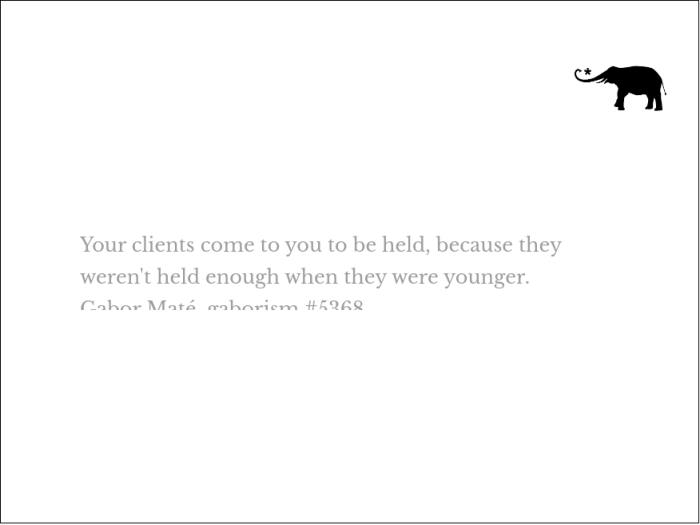As the brilliant Gabor Maté, my teacher, says, “All trauma is an attachment wound.”
Wait, what?
Gabor, what about car accidents, tsunamis, disasters? What do they have to do with attachment?
Well, it turns out attachment is one of the few things that can help us ‘repair’ a wounded heart – or to put it in more technical terms, an overwhelmed nervous system.
A toddler at the beach can be completely (and lastingly) overwhelmed by a wave a pre-teen will jump in with relish. Or by the loss of a stuffed animal, or by the perception of abandonment.
And grown-ups, since times immemorial pick up the child, offer it the comfort of their body, their voice, their calm, their strength – their much more calm and mature nervous system. This allows the child to release the agony of fear triggered by their own immature nervous system. That nervous system is not sadistic, it is simply primed for survival, geared to give us the violent charges we need to survive. There is no stronger energy in humans.
Survival terror → comfort and safety → discharge of the survival energy.
This is the way it goes, a million times before we reach adulthood. Ideally, by that time our nervous systems have integrated enough safety and comfort through repetition and osmosis and continuous contact with kind, empathic, attuned and responsible adults.
Ideally.
I’ve yet to meet a human whose safety integration had been sufficient. Or maybe they don’t find their way to a therapy room. But for a huge majority of people, some portion of that survival energy got stuck somewhere in our nervous system and is still tasering us with maddening regularity = trauma.
In our profession, we have two orientations to support the liberation of people from trauma. I can’t use the word ‘protocol’ as it’s more art than a set of steps.
The first one is to create a situation and relationship of an UNSHAKEABLY SAFE nature. Humanistic therapy, created by Carl Rogers, is based on that foundation. The magic sauce in any talk therapy is the quality of the relationship between client and therapist, which is always an alchemical mystery (otherwise, US medical insurance companies would have found a way to monetize it – but I digress).
A truly kind, safe, attuned grown-up who has your back – in childhood or adulthood – is a wondrous gift. I could not possibly overrate the soul repair that can come from such a relationship. It takes time, discernment, love. My own relationship with my therapist Isabelle de Roux, saved my sanity and possibly my life.
However, the sensitive reader may have noticed we’re missing a piece of the healing puzzle. I am immensely grateful to this field’s pioneers, Peter Levine, Bessel van der Kolk, Stephen Porges, and many others who have connected the mind to the body in the face of decades-long medical derision.
The piece we’re rediscovering thanks to them is the somatic (from the Greek soma, meaning the body). As Peter Levine says, ‘People think trauma is a mental problem. It’s not.’
Trauma happens (and stays) in the body. Trauma is survival energy that got stuck inside.
Do you remember the worst fear, panic, anger, grief you ever felt? What would happen to you if you’d had to hide it, pretend it wasn’t happening, the staccato of your heart, your bellowing breath, the collapse of your heart, the sudden flush of heat? How would that feel to have to suppress this violent, if uncomfortable energy? Would it feel like you swallowed a supernova, maybe? Now imagine all that energy still bouncing about your nervous system like a demented pinball machine ball with no exit. For years. For decades.
We learn to dissociate from our physical sensations to stop feeling. We desperately turn to substances and processes that distract us. Or we stay chronically angry, chronically sad, chronically terrorized.
I don’t tests to know that every single person in recovery, or depression or eating disorders is dealing with trauma in the best way they know. If anything, this should help us expand our compassion exponentially.
We need to defuse the supernova. We need to somatically release the survival energy that got trapped in our nervous systems. Gently, kindly, lovingly.
So here are my two humble offerings;
As Gabor says ‘Your clients come to you to be held, because they weren’t held enough when they were younger’. We must create safety. Staunchly, adamantly commit to seeing the best in our clients, to have their backs. To reflect their wonderfulness back to them. To help them through shame, fear, guilt, anger. To help their take ownership and accountability for their lives. Essentially, bringing all the best qualities of parenting to the table.
Then help them access and release trauma from their bodies. I work closely with a Feldenkrais method practitioner, I’m training in various forms of Somatic Experiencing. To my delight, the practitioners from the mind and the body fields are now reaching across the artificial divide to meet in the middle. We must join both sides in order to effectively help our clients back to wholeness











Read 0 comments and reply